Tillandsia harmsiana
Click thumbnails for full size, scaled to a new window.
Tillandsia harmsiana
Previously classified as Vriesea.
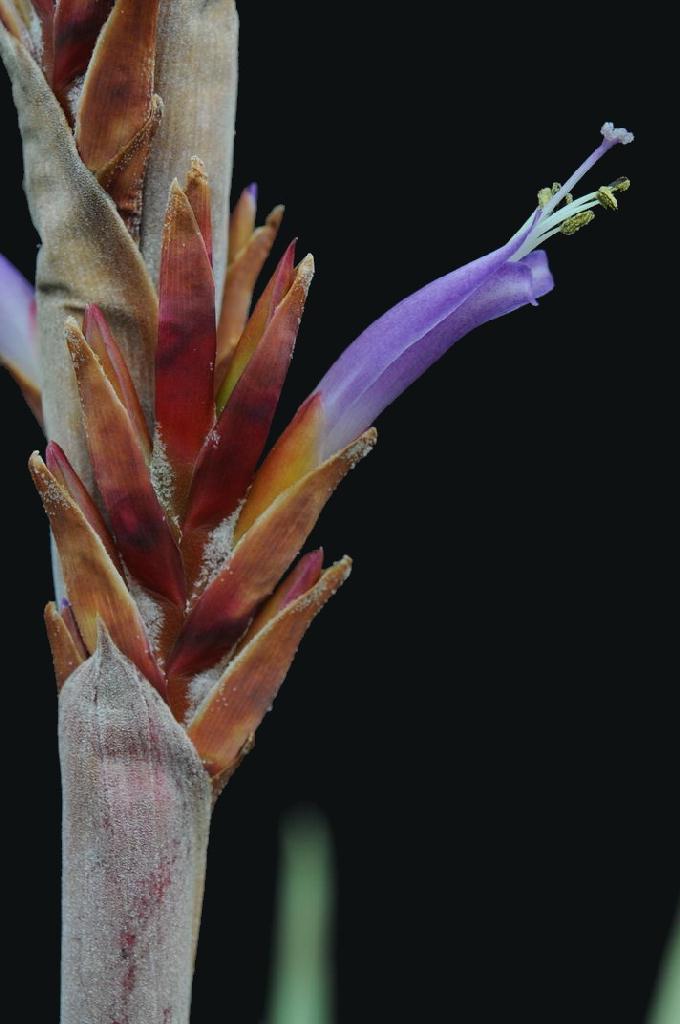
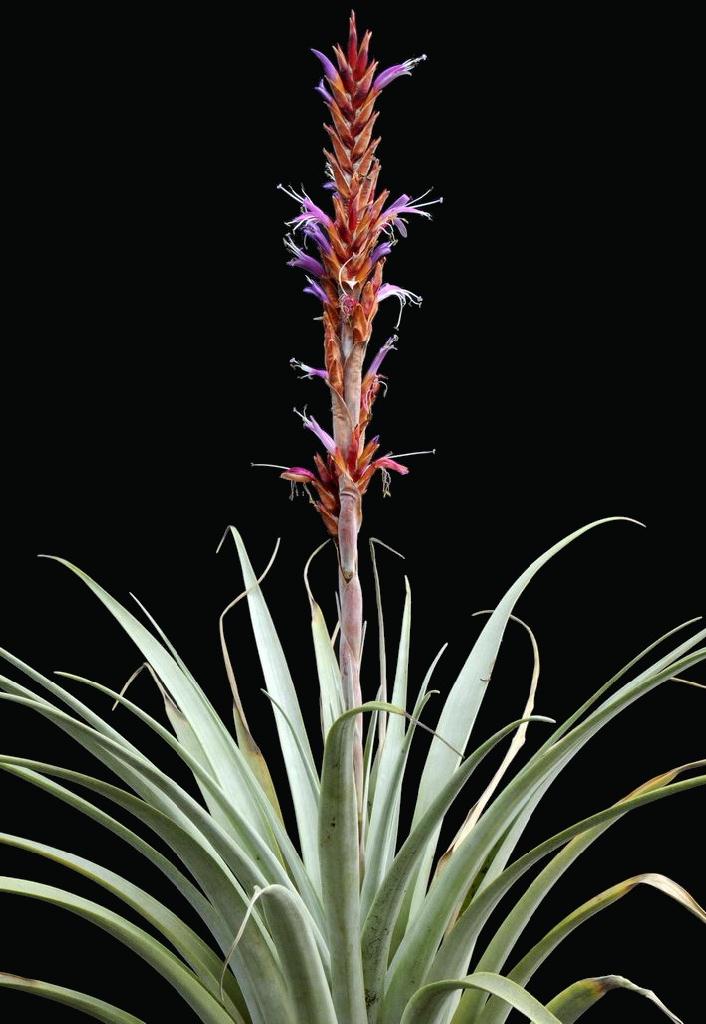
| Peter Tristram 04/11. (70cm tall, fb 25-35mm) |

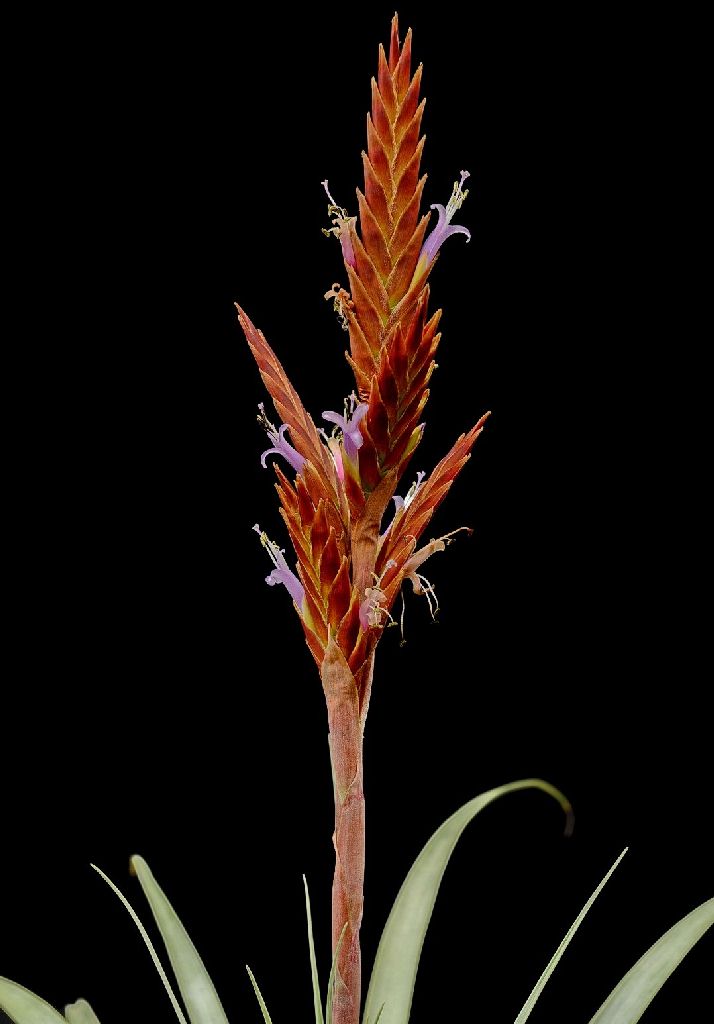
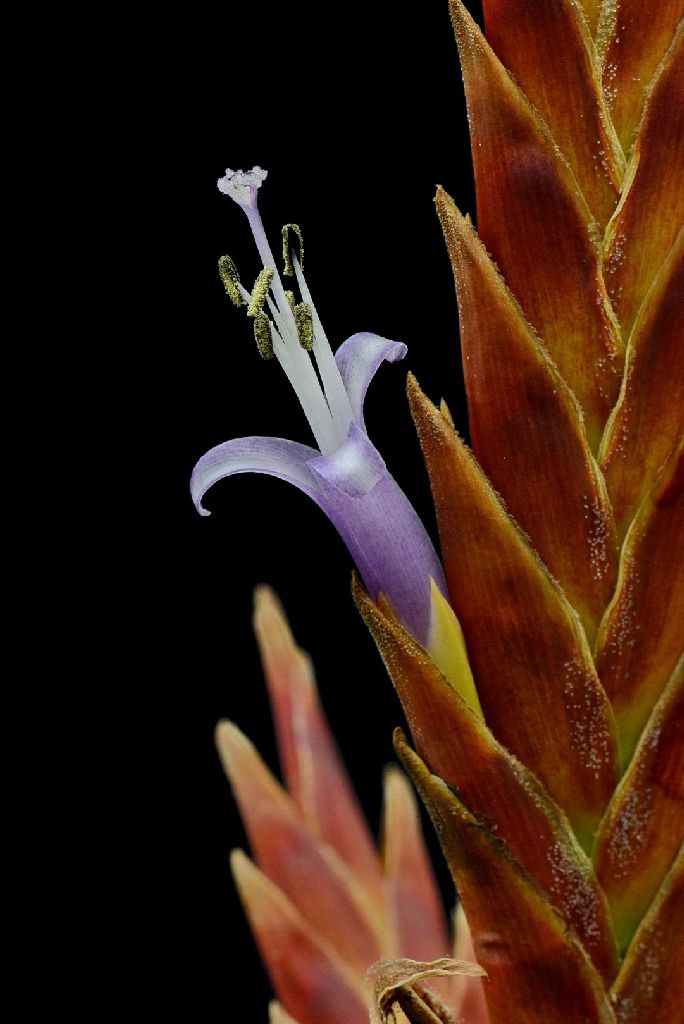 Peter Tristram ... "I obtained this specimen, as a small pup, from Lotte Hromadnik on my visit to Europe in 2011. Always after TVs, I spied the mother plant in a fruit tree with an old spike so she sold me a pup, suggesting it could be TV harmsiana. There was an appenii mother too, which is budding as well but the much rarer petrea will be a while before it blooms. I am pretty sure she was correct with harmsiana, making this the third clone of this species that I have with the other two already posted over the years. Both this one and the one that was collected at Llacanora, near Cajamarca in 2003, have the purple flowers and interesting burgundy coloured floral bracts so they are potentially from the same location. I think the plant came from near Cajamarca in Peru but I have emailed Lotte for her data as it’s not on the list I have."
Peter Tristram ... "I obtained this specimen, as a small pup, from Lotte Hromadnik on my visit to Europe in 2011. Always after TVs, I spied the mother plant in a fruit tree with an old spike so she sold me a pup, suggesting it could be TV harmsiana. There was an appenii mother too, which is budding as well but the much rarer petrea will be a while before it blooms. I am pretty sure she was correct with harmsiana, making this the third clone of this species that I have with the other two already posted over the years. Both this one and the one that was collected at Llacanora, near Cajamarca in 2003, have the purple flowers and interesting burgundy coloured floral bracts so they are potentially from the same location. I think the plant came from near Cajamarca in Peru but I have emailed Lotte for her data as it’s not on the list I have."
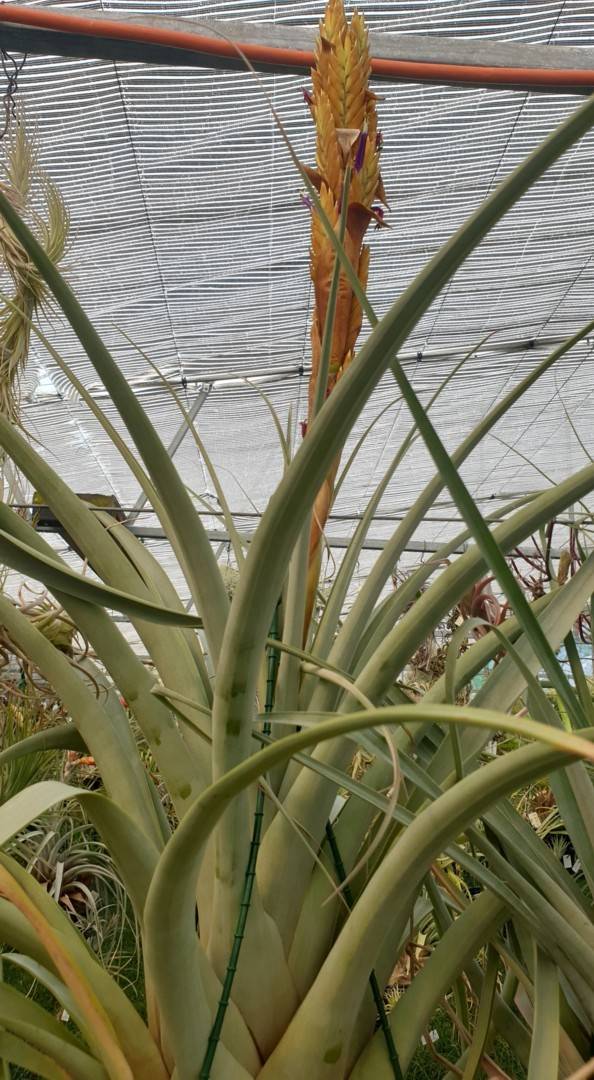
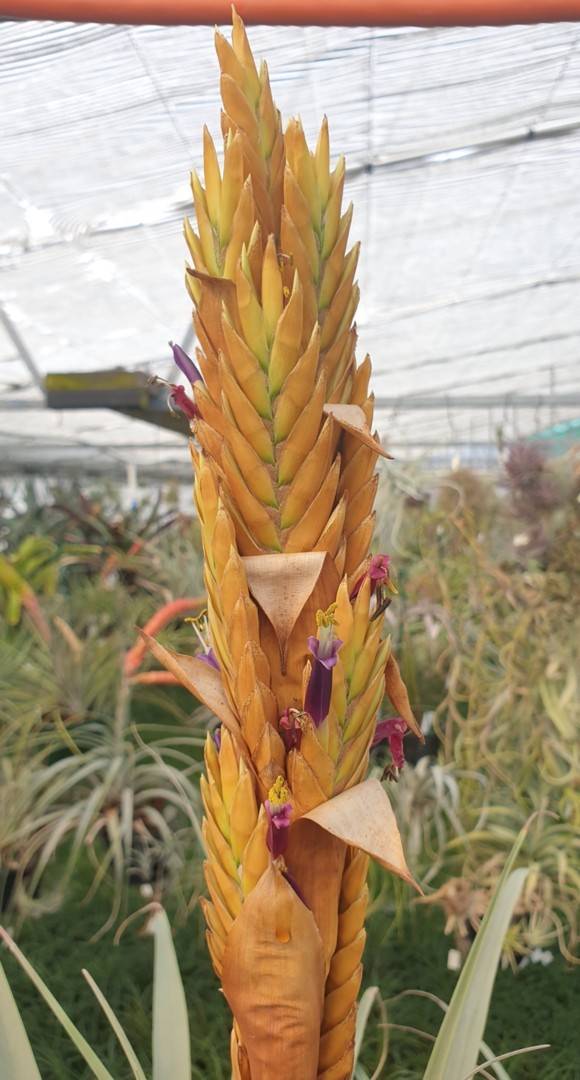 Chris Larson ... "This one has been sitting still for a while - with its "burnt spike" look. I had it in the BSV show 6 weeks ago. Now the flowers are out. Quite lovely. Ex Peter Tristram."
Chris Larson ... "This one has been sitting still for a while - with its "burnt spike" look. I had it in the BSV show 6 weeks ago. Now the flowers are out. Quite lovely. Ex Peter Tristram."
Peter Tristram ... "Nice! Is it the one from Knize? It seems to me that these harmsiana sort of plants grow all over the place in the Andes and vary in size greatly too. The giant ones we got from K.Knize are well over 1m tall! Are they really all the same species, give or take an aff. or a cf.? Lots of mine are in bloom too, from KK (Peru I assume) and the Germans (Ecuador and Peru) so I must make some comparisons. They all survived the 6 week drenching too, though no flowers until the rain stopped a week ago."
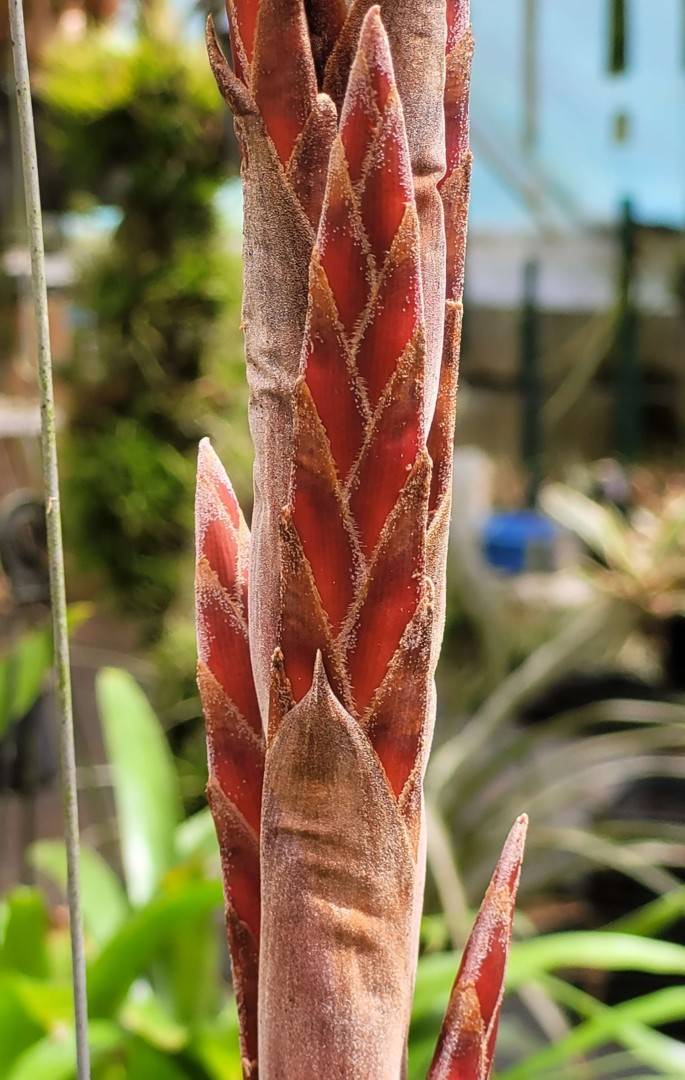
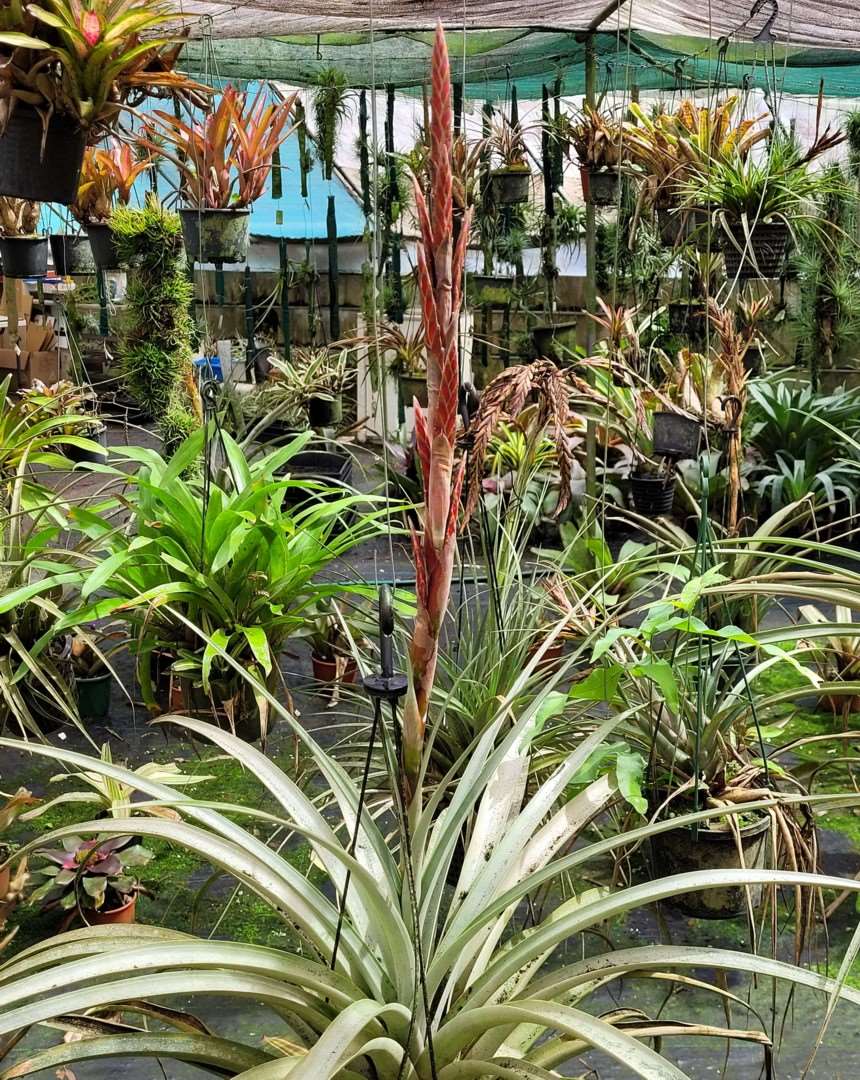
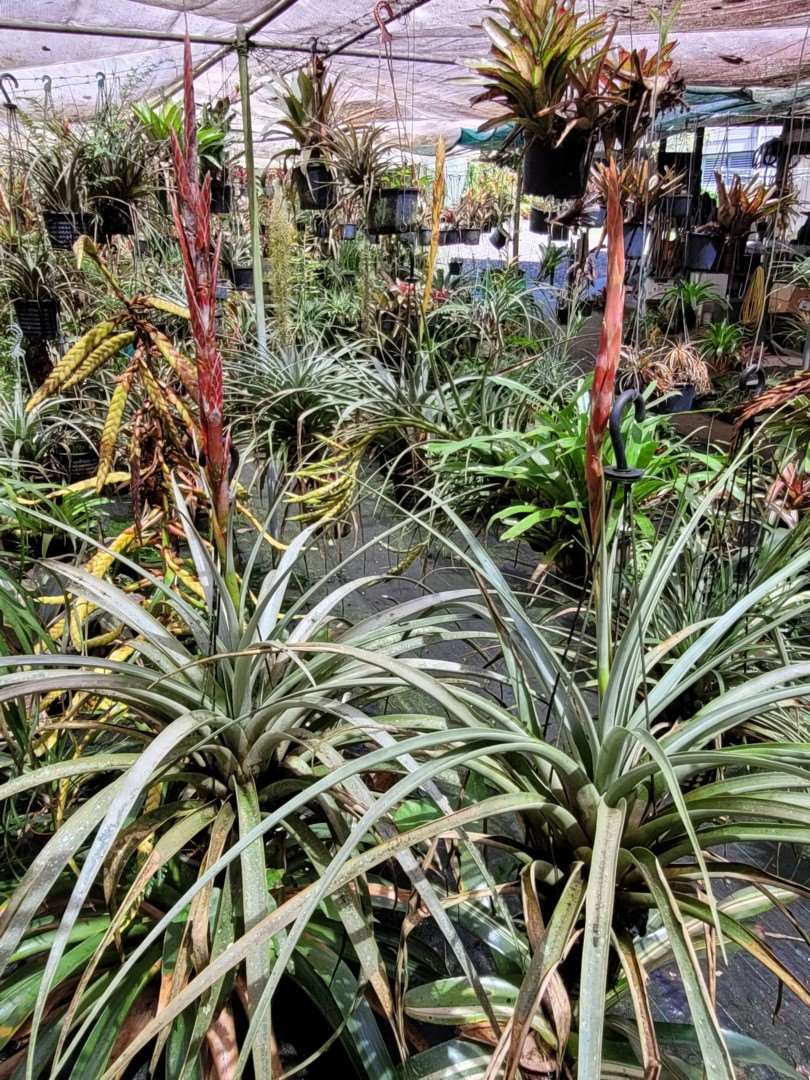
| Peter Tristram 02/22 aff harmsianared spike ex. K.Knize |
Peter Tristram ... "Tillandsia subg. Pseudovriesea, the TV group, has interested me for years. Unfortunately the restrictions on bromeliad importing have curtailed my desires BUT there are still plants in my collection, especially from Knize, that surprise. We used to call them the 'silver Vrieseas' as flowers of the species have nectar scales so keyed to Vriesea despite looking like Tillandsias. Maybe they could be called the TP group now, but it doesn't have the same ring.
Not all are easy to grow without climate control conditions though many are and thrive in collections. Even the soggy conditions of the last year or so haven't been too detrimental on the more open rosette species with harder leaves. Unfortunately, though, the group is poorly botanised and possibly poorly speciated. The botanists, over the years, have lumped plants that have bloomed for me into a few broad groups – olmosana, hitchcockiana/cereicola, andreetae, harmsiana and porphyrocraspeda/tequendamae (Vr. cylindrica). At the moment there are quite a few in the blooming process including these two. The aff. olmosana var olmosana (as identified by HEL) was collected by MF, MR and me in Nth Peru in 2003 and the possible aff harmsiana, with the dark red spike, was imported from Knize.
Taxonomy is needed! More on this group soon."
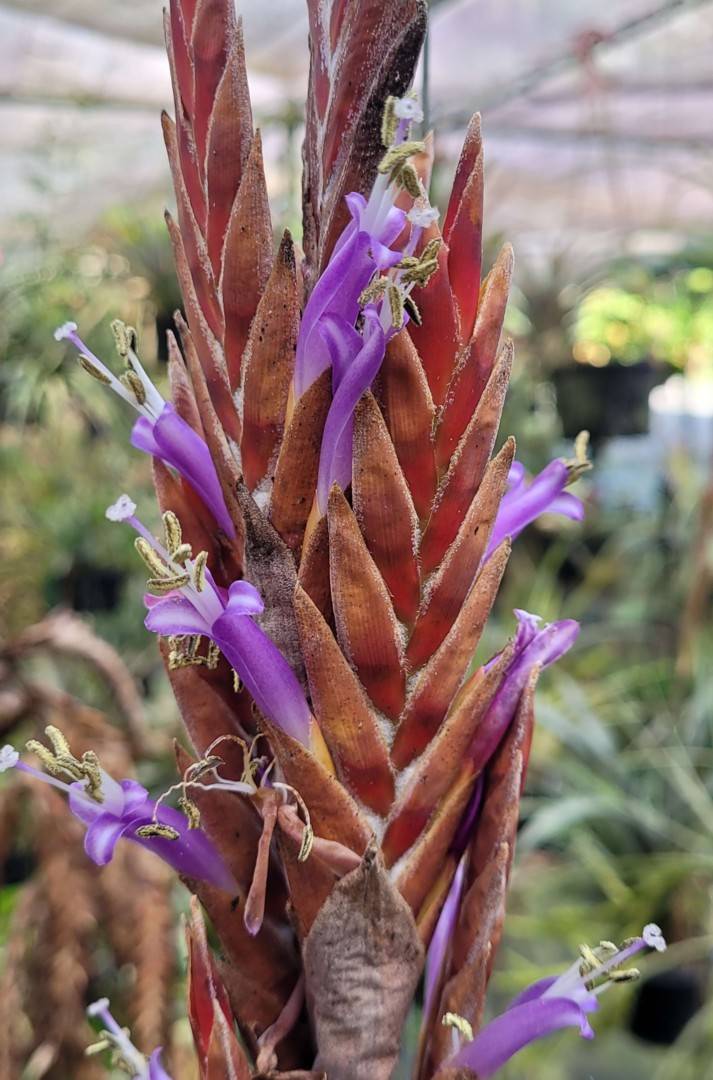
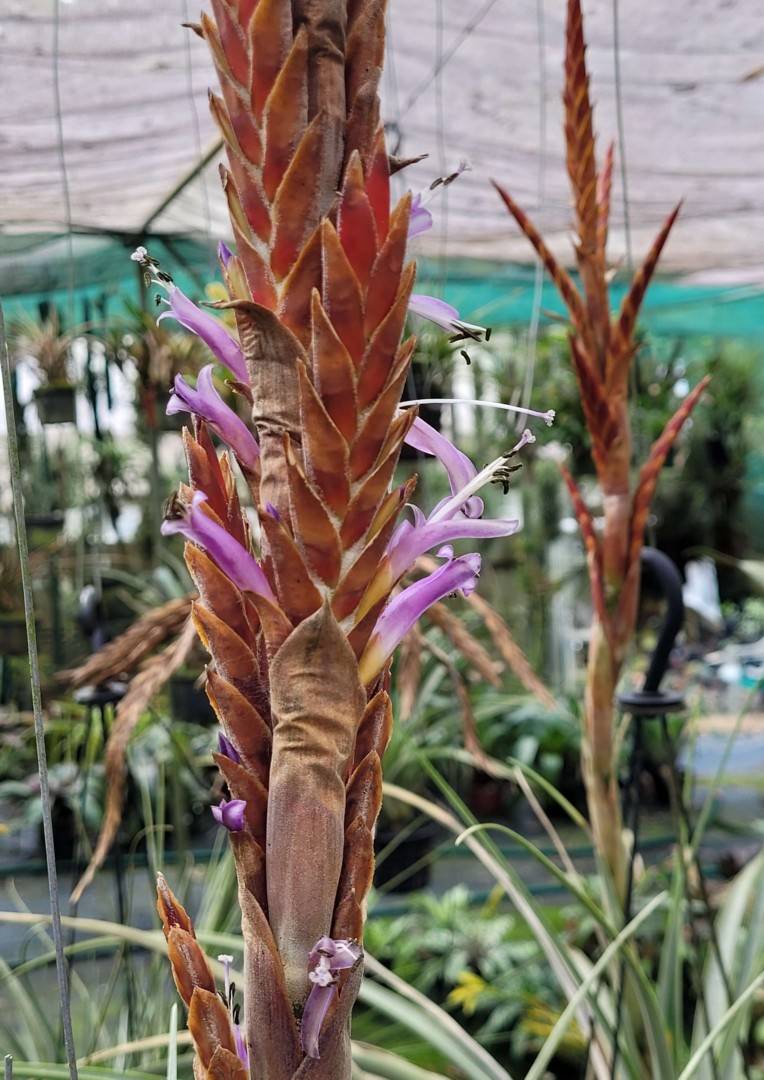
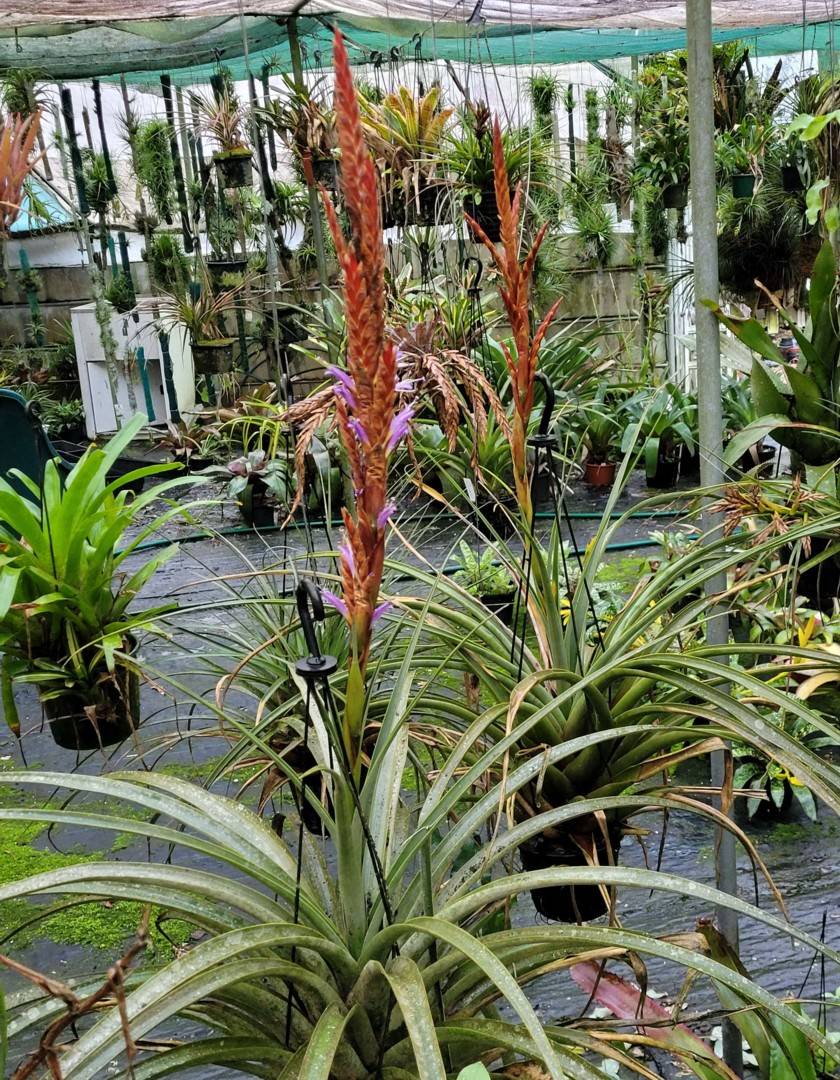
| Peter Tristram 03/22 aff harmsiana now in flower |
Peter Tristram ... "The aff. harmsiana, which might key to the species if I get around to a closer examination, is very similar to the one I obtained from Lotte and posted, some years ago. Lotte’s one is coming into bloom too - same coppery red bracts and almost reddish lilac flowers. I haven’t bloomed one since the first blooming. The two in the pics came from different sources though ultimately ex Knize in Peru (KK). The one blooming was from Lydia, the other from KK. According to my files, Lotte’s plant was collected on limestone bluffs near Llacanora, not far from Cajamarca, where the non-furry tectorum grow too. "
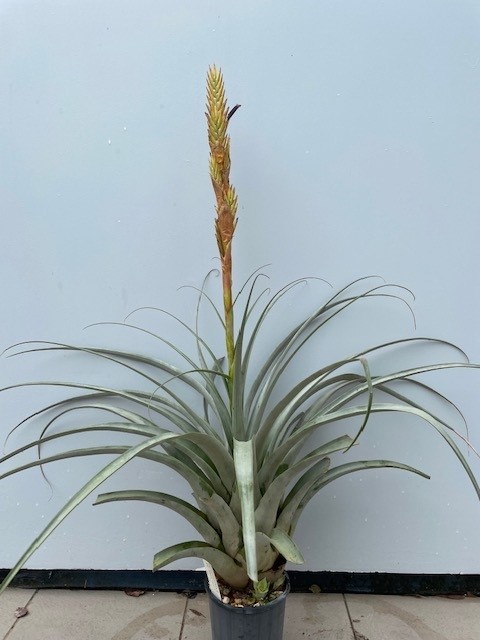
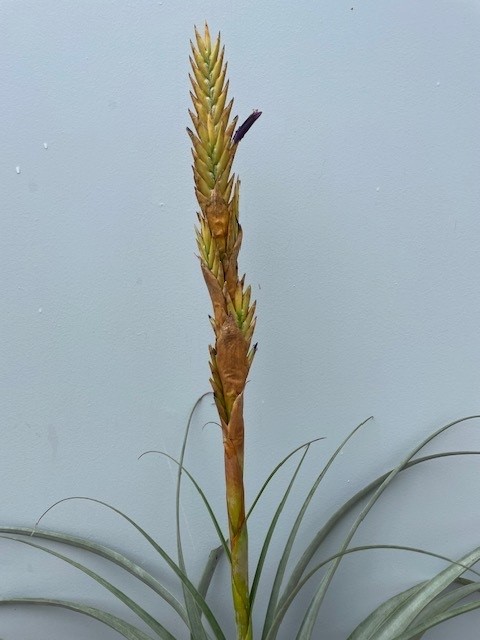
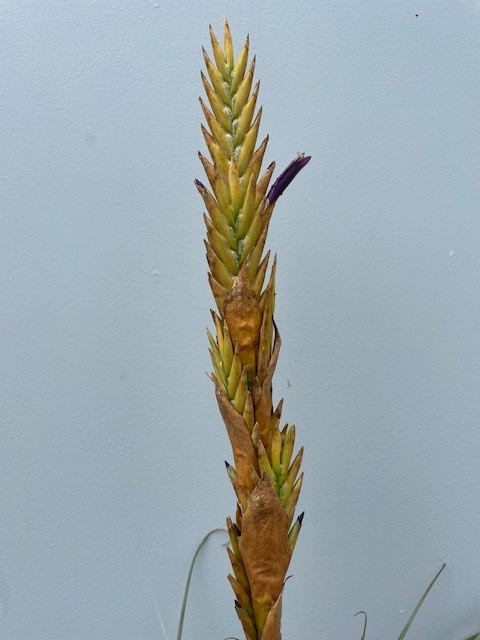
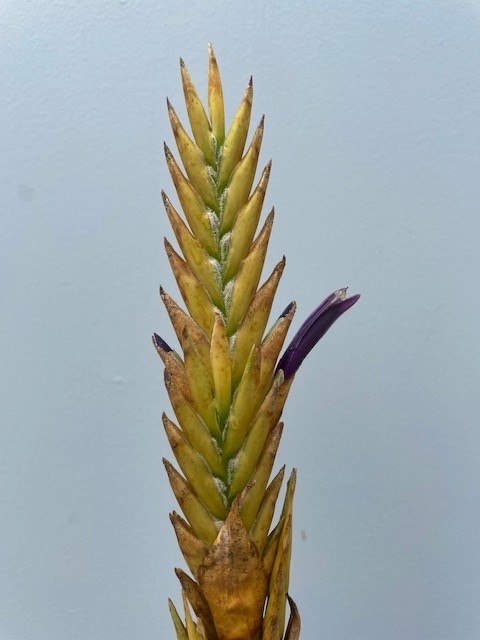
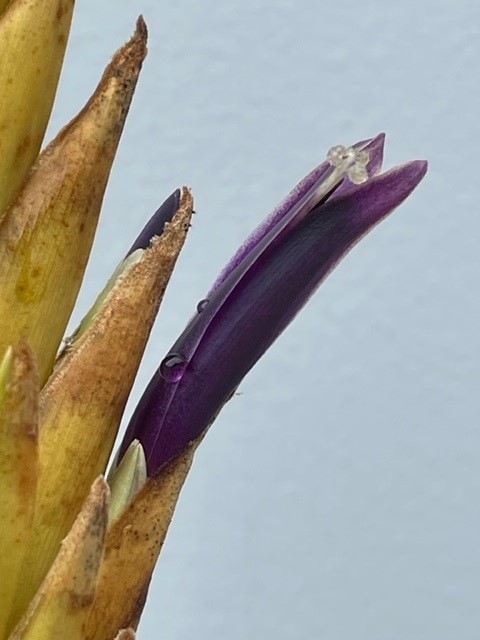 Chris Larson ... "Great photos Bruce. When I flowered mine, people thought that it looked like the flower spike had been burnt. Maybe so - but I reckon it is spectacular."
Chris Larson ... "Great photos Bruce. When I flowered mine, people thought that it looked like the flower spike had been burnt. Maybe so - but I reckon it is spectacular."
Tillandsia harmsiana L B Smith, Contr. Gray Herb. 98: 16. 1932, see Grant in Phytologia 75(2): 170-175. 1993
Vriesea harmsiana (L. B. Smith) L. B. Smith, Contr. U. S. Natl. Herb. 29: 447. 1951 ; as "Vriesia."
Desc from S&D p1253
Plant flowering 6 dm or higher.
Leaves 6 dm long;
Sheaths ovate-elliptic, 20-25 cm long, dark brown, densely appressed-lepidote;
Blades narrowly triangular, attenuate, 4 cm wide, cinereous-lepidote throughout.
Scape erect, stout;
Scape-bracts densely imbricate, ovate with long narrow recurved blades.
Inflorescence bipinnate from about 7 spikes, densely cylindric, 30 cm long, less than 5 cm wide;
axis completely covered by the spikes and bracts;
Primary bracts erect, ovate, acute, tightly enfolding the bases of the spikes;
Spikes strict, straight, linear-lanceolate, acute, complanate, 11-15 cm long, 3 cm wide, 12-20-flowered;
rhachis winged and enfolding the flowers, densely lepidote.
Floral bracts imbricate, ovate, acute, 3-4 cm long, exceeding the sepals but not covering the rhachis, carinate, yellow-brown with a purple base, diffusely to densely lepidote;
Flowers pedicellate, 5 cm long.
Sepals free, narrowly ovate, 3 cm long, ecarinate, glabrous;
Petals narrow, purple, bearing 2 highly adnate scales;
Stamens slightly exserted; pistil exserted.
Type. Macbride 3272 (holotype F, isotype GH), Mito, Huanuco, Peru, Apr 1923.
DISTRIBUTION. Saxicolous and epiphytic, steep rocky shrubby slopes, 2300-3000 m alt, northern Peru.
PERU. CAJAMARCA: Llacanora, 18 Mar 1965, Sanchez 170 (US); Cerro Huacaris, 22Jun 1966, Sanchez 235 (US); Huambos, 3 Ju11968, Carmona 5127 (US, USM). AMZONAS: Molinopampa, Chachapoyas, 19 Jul 1962, Wurdack 1400 (US); s d, Rauh 20462 (US). LIBERTAD. Allaigon, Huamachuco, 25 Jun 1958, Lopez & Sagastegui 2770 (TRP, US).
Tillandsia Harmsiana, L B Smith, Contr. Gray Herb. 98: 16, pl. 4, figs. 12-15. 1932
Florifera 6 dm. alta vel ultra, verisimiliter multo altior: foliis anguste triangularibus, acuminatis, 6 dm. longis, basi 4 cm. latis, omnino dense adpresseque cinereolepidotis: scapo erecto, valido; scapi bracteis dense imbricatis, ovatis cum laminis longis angustis recurvatisque: inflorescentia bipinnatim paniculata, e spicis ca. 7 composita, dense cylindrica, 30 cm. longa, infra 5 cm, lata; axe spicis bracteisque omnino obtecto; bracteis primariis ovatis, acutis, erectis, spicarum bases arte vaginantibus: spicis rectis, stricte erectis, lineari-lanceolatis, acutis, 11-15 cm. longis, 3 cm. latis, 12-20-floris; rhachi dense lepidota, ad florum receptionem valde excavata: bracteis ftorigeris imbricatis, ovatis, acutis, 3-4 cm. longis, quam sepala longioribus sed rhachin non obtegentibus, carinatis, dissite lepidotis, aureo-brunneis, basi purpureis: floribus stipitatis, 5 cm. longis; sepalis liberis, anguste ovatis, 3 cm. longis, glabris, ecarinatis; petalis angustis, purpureis, intus callis binis verticalibus auriculatis. auctis; staminibus petala subaequantibus; stylo exserto.
Pl. IV, figs. 12-15.
PERU: HUANUCO: steep rocky shrubby slopes, Mito, alt. ca.. 3000 m:, 1923, Macbride 3272 (FM, TYPE; G).
The spikes of this species closely resemble that of T. lateritia Andre, and the petals have pronounced lateral folds as in T. lateritia and with the summits of the folds definitely auricled so that at first glance they might be taken for the scales found in Vriesia.
Updated 22/04/22

















